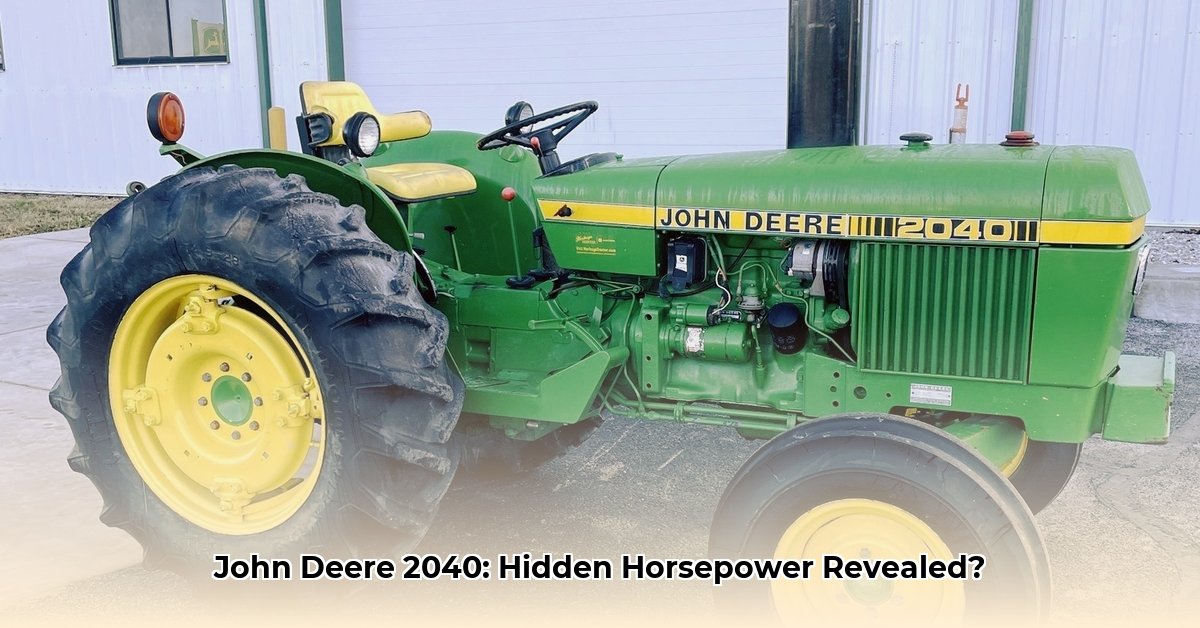
A German-Engineered Workhorse: The John Deere 2040
The John Deere 2040, a utility tractor produced from 1976 to 1982 in Mannheim, Germany, represents a fascinating chapter in agricultural machinery. Its design, reflecting the economic realities and technological advancements of the era, provides valuable insight into the evolution of farming practices. But how much horsepower did this seemingly unassuming machine truly possess? This article delves into the specifics of the John Deere 2040, exploring its technical specifications, performance, and lasting legacy. For more on 1980s John Deere tractors, see this site.
Historical Context: The 2040 in its Time
The 1970s brought significant changes to agriculture. Rising fuel prices and increased awareness of efficiency spurred the development of tractors like the John Deere 2040. Its German manufacturing location, unusual for John Deere at the time, reflects a broader strategy targeting European markets and leveraging German precision engineering expertise. The 2040 emerged as a response to the demand for dependable, cost-effective power in a changing agricultural landscape. This focus on efficiency and robust design is reflected in its lasting reputation for durability amongst collectors today.
Technical Specifications: Power Under the Hood (and Beyond)
The John Deere 2040 was powered by a 2.7-liter, three-cylinder diesel engine. While John Deere advertised 40 PTO horsepower, independent tests from various sources yielded slightly lower figures, averaging around 32.87 drawbar horsepower (the force used for pulling) and 40.86 PTO horsepower. The discrepancy highlights the complexities of horsepower measurement methodologies during that period and the differences between rated and actual power in real-world applications. Were these discrepancies significant for farmers? It depends greatly on the tasks involved; heavier tasks may have seen more of a difference.
The tractor featured an eight-speed collar shift transmission, offering a range of gears for varying field conditions. A significant upgrade in 1978, for serial numbers 266750 onwards, saw the introduction of a closed-center hydraulic system replacing the earlier open-center design. This increased efficiency and responsiveness, enhancing the precision of the tractor for diverse farm operations.
Key Specifications:
| Feature | Specification |
|---|---|
| Engine | 2.7L, 3-cylinder diesel |
| Transmission | 8-speed collar shift |
| PTO Horsepower (Claimed) | 40 hp |
| PTO Horsepower (Tested) | Approximately 40.86 hp |
| Drawbar Horsepower (Tested) | Approximately 32.87 hp |
| Production Years | 1976-1982 |
| Manufacturing Location | Mannheim, Germany |
Performance and Capabilities: A Workhorse in Action
The 2040’s compact size made it highly maneuverable, particularly valuable in smaller fields. While not the most powerful tractor available, its power was adequate for a range of tasks, including plowing, planting, and hauling moderate loads. Its reliability and ease of use were frequently praised by users of the day – but did it meet all farming needs? Heavy-duty operations might have stretched its capabilities, necessitating the use of larger models.
Maintenance and Parts Availability: Keeping the 2040 Running
Maintaining a vintage tractor like the John Deere 2040 requires specialized knowledge and access to spare parts. While some parts remain available through dedicated online communities and specialist suppliers, others might be difficult to source. Restoring a 2040 can be both rewarding and challenging, requiring a degree of mechanical aptitude and persistence.
Collector's Value and Market Trends: A Valuable Piece of History
The John Deere 2040 has gained a following amongst collectors. Its rarity and association with a specific era in agricultural history contribute to its increasing value. The condition and level of restoration significantly influence its market price. This makes the restoration process not only a labor of love but a potentially worthwhile investment.
Comparison with Contemporaries: The Competitive Landscape
The John Deere 2040 competed with other utility tractors from manufacturers like Ford, Massey Ferguson, and International Harvester. While a direct horsepower comparison is challenging due to varying testing methodologies, the 2040 held its own, offering a combination of reliability, maneuverability, and sufficient power for various agricultural tasks.
Conclusion: A Lasting Legacy
The John Deere 2040, despite its modest horsepower compared to modern tractors, represents a significant milestone in agricultural technology. Its German engineering, robust design, and solid performance secured its place in farming history. It serves as a testament to the continuous drive for efficiency and adaptation in agricultural machinery, a legacy that persists even amidst rapid technological advancements.